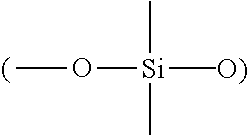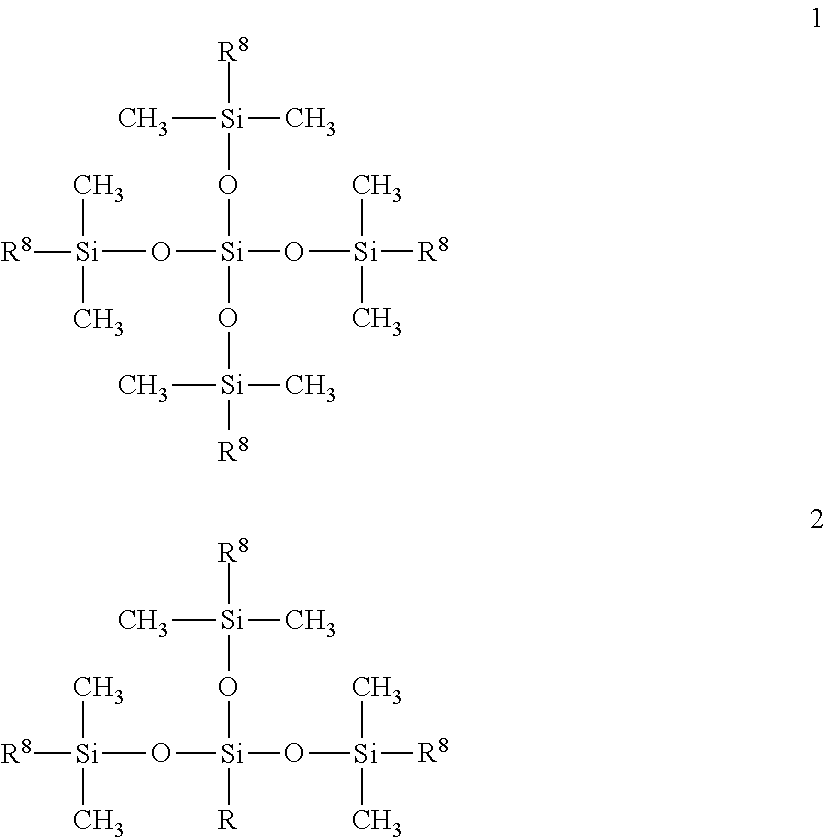Surfactant-free organopolysiloxane invert emulsions
a technology of organopolysiloxane and invert emulsion, which is applied in the field of waterinoil emulsion, can solve the problems of limited choice of surfactant, large quantity of surfactant, and difficulty in preparation of such emulsions
- Summary
- Abstract
- Description
- Claims
- Application Information
AI Technical Summary
Benefits of technology
Problems solved by technology
Method used
Image
Examples
example 1
Preparation of a Linear Self-Emulsifying Organopolysiloxane
[0079]The reaction flask was charged with a poly(methylsiloxane-co-dimethylsiloxane) of approximate formula MH(D)x(DH)yMH [225.0 g, 0.786% w / w H content; x=7 approx., y=7 approx.]. The flask was heated to 80° C., alpha-methylstyrene (AMS, 160.7 g) was charged to the addition funnel, and approximately one-third of the AMS was added to the flask. The temperature of the flask contents was raised to about 100° C., and a solution of chloroplatinic acid in cyclohexanol (1% Pt w / w in the alcohol, 108 μL) was added quickly to the stirring (200-255 rpm) mixture in the flask via a syringe. A rapid exotherm ensued. AMS addition from the funnel was continued to keep the temperature in the range 140-160° C. from the heat of reaction. Upon completion of AMS addition, the mixture was heated at 145° C. for 30 minutes. The temperature was then lowered to 140° C., and 1-octadecene (51.5 g) was added slowly from the addition funnel. Immediatel...
example 2
Preparation of a Branched Self-Emulsifying Organopolysiloxane
[0080]The reaction flask was charged with tetrakis(dimethylsiloxy)silane [TDSS, 41.0 g, 1.225% w / w H content]. The flask was heated to 80° C. Alpha-methylstyrene (AMS, 29.4 g) was charged to the addition funnel, and approximately one-third of the AMS was added to the flask. The temperature of the flask contents was raised to about 100° C., and a solution of chloroplatinic acid in cyclohexanol (1% Pt w / w in the alcohol, 31 μL) was added quickly to the stirring (200-255 rpm) mixture in the flask via a syringe. A rapid exotherm ensued. AMS addition from the funnel was continued to keep the temperature in the range 140-160° C. from the heat of reaction. Upon completion of AMS addition, the mixture was heated at 145° C. for 30 minutes. The temperature was then lowered to 140° C., and 1-octadecene (33.0 g) was added slowly from the addition funnel. Immediately after the start of octadecene addition, an aliquot of Pt catalyst (15...
example 3
[0081]In a 250 mL plastic beaker, 30 g of the silicone fluid of Example 1, with octadecyl, 2-phenylpropyl and polyether (10 moles of ethylene oxide unit) functionalities, was taken. The fluid was stirred with an overhead stirrer at 2000 rpm. To this stirring liquid, 30 g of deionized water (50% water content for the end composition) was added very slowly, over a period of 35 minutes. The milky white emulsion was optionally homogenized with a T25 UltraTurrax for 2 minutes at 8000 rpm. A smooth, creamy, white, water-in-oil type emulsion resulted that was stable against separation at room temperature for more than six months. The emulsion was also stable against separation after centrifugation for 2 hours at 4000 rpm. The emulsion cannot be diluted with water but can be diluted with non-polar solvents such as isododecane. Average particle size measured with a Malvern Zetasizer instrument was approximately 303 nm. The emulsion was shear thinning. The emulsion was stable even when the wa...
PUM
| Property | Measurement | Unit |
|---|---|---|
| molecular weight | aaaaa | aaaaa |
| refractive index | aaaaa | aaaaa |
| particle size | aaaaa | aaaaa |
Abstract
Description
Claims
Application Information
 Login to View More
Login to View More - R&D
- Intellectual Property
- Life Sciences
- Materials
- Tech Scout
- Unparalleled Data Quality
- Higher Quality Content
- 60% Fewer Hallucinations
Browse by: Latest US Patents, China's latest patents, Technical Efficacy Thesaurus, Application Domain, Technology Topic, Popular Technical Reports.
© 2025 PatSnap. All rights reserved.Legal|Privacy policy|Modern Slavery Act Transparency Statement|Sitemap|About US| Contact US: help@patsnap.com



